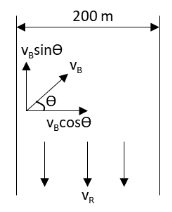
A boat crosses a river of width
A.
B.
C.
D.
Answer
468k+ views
Hint: Use the formula for velocity of an object. Write the equation for velocity of the boat and velocity of the river. Then draw the diagram representing the velocities of the river and boat. Then from this diagram determine the resultant velocity of the boat to cross the river. Hence, determine the time required to cross the river.
Formula used:
The velocity
Here,
Complete step by step answer:
We have given that the width of the river is
The time taken by the boat to cross the river is
The boat experiences the drift due to velocity of the river given by
Let us now draw the diagram showing the velocities of the boat and river.

From the above diagram, we can see that the velocity of the river gets cancelled by the vertical component of velocity of the boat.
Substitute
The velocity
From equation (2). We can write
Here,
Substitute
Substitute
Therefore, the time required for the boat to cross the river by shortest path is
Hence, the correct option is D.
Note: The students should keep in mind the velocity of the river causes the boat to experience the drift. Hence, one should not forget to consider the velocity of the river and this drift of the boat. Also the students should keep in mind that the vertical component of velocity of the boat gets cancelled with velocity of the river. Hence, the only velocity of the boat is its horizontal component.
Formula used:
The velocity
Here,
Complete step by step answer:
We have given that the width of the river is
The time taken by the boat to cross the river is
The boat experiences the drift due to velocity of the river given by
Let us now draw the diagram showing the velocities of the boat and river.

From the above diagram, we can see that the velocity of the river gets cancelled by the vertical component of velocity of the boat.
Substitute
The velocity
From equation (2). We can write
Here,
Substitute
Substitute
Therefore, the time required for the boat to cross the river by shortest path is
Hence, the correct option is D.
Note: The students should keep in mind the velocity of the river causes the boat to experience the drift. Hence, one should not forget to consider the velocity of the river and this drift of the boat. Also the students should keep in mind that the vertical component of velocity of the boat gets cancelled with velocity of the river. Hence, the only velocity of the boat is its horizontal component.
Recently Updated Pages
Master Class 11 Economics: Engaging Questions & Answers for Success

Master Class 11 Business Studies: Engaging Questions & Answers for Success

Master Class 11 Accountancy: Engaging Questions & Answers for Success

Master Class 11 English: Engaging Questions & Answers for Success

Master Class 11 Computer Science: Engaging Questions & Answers for Success

Master Class 11 Maths: Engaging Questions & Answers for Success

Trending doubts
State and prove Bernoullis theorem class 11 physics CBSE

1 ton equals to A 100 kg B 1000 kg C 10 kg D 10000 class 11 physics CBSE

State the laws of reflection of light

One Metric ton is equal to kg A 10000 B 1000 C 100 class 11 physics CBSE

Difference Between Prokaryotic Cells and Eukaryotic Cells

1 Quintal is equal to a 110 kg b 10 kg c 100kg d 1000 class 11 physics CBSE




